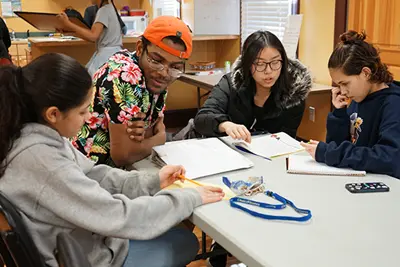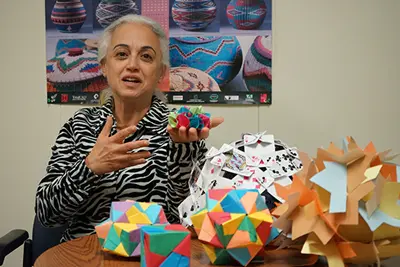Live Actors Interact with Students in Virtual Classroom
 Image by K. Webster
Image by K. Webster
Undergraduate education majors Mykala Guzman and Angela Messina practice teaching a lesson in a virtual classroom.
11/13/2018
By Katharine Webster
“Jasmine” sometimes nods off or stares at her cellphone during class. “Ethan” blurts out answers without raising his hand first, while “Dev” rarely speaks unless he’s called upon. “Ava” drums her fingers on the table, distracting the other students.
These are typical behaviors of typical elementary school students. But “Jasmine” and her classmates aren’t real students: They’re avatars that allow undergraduate education majors to practice teaching on virtual students before they start teaching real ones at the Murkland Elementary School in Lowell.
In a first-year class taught by Clinical Assoc. Prof. Michelle Scribner-MacLean, honors education major Angela Messina and her partner presented a lesson on telling time. The avatars were antsy and distracted, chatting when they were supposed to be listening, or tuning out altogether.
 Image by K. Webster
Image by K. Webster
The vehicle for the teaching exercise is Mursion, a virtual reality platform that provides a video link to a simulated classroom, in a format similar to an online multiplayer game. The Mursion sessions take place in real time and combine real actors, or “inter-actors,” with artificial intelligence to animate avatars for five different children, each of whom has a different personality and educational needs.
Scribner-MacLean schedules each session in advance, choosing a scenario and grade level that allows her students to practice a particular skill, such as engaging pupils academically or managing their behavior.
“The feedback we were getting from our students and our community partners was that more experience in classroom management would be helpful,” Scribner-MacLean says. “With Mursion, our students can make mistakes and get feedback before they interact with real students. Now, when they go out into the field and do their first lesson, I see more confidence and fewer rookie mistakes.”
During a recent class, five pairs of students presented different lesson plans to the avatars, with varying degrees of success. Each pair presented their lesson for five minutes, then took five minutes to reflect on the experience and listen to comments from their classmates and Scribner-MacLean.
 Image by K. Webster
Image by K. Webster
Sarah Robinson, left, monitors her virtual pupils' behavior while MacKenzie Ozaroff reads them a book.
“It’s challenging,” she says. “Up until now, a lot of us believed that, ‘Oh, we’re just going to teach and they’re going to listen.’ I realized we’re not just teaching the lesson; we’re teaching behavioral skills as well.”
Right now, Mursion is used in classes for first-year undergraduate education majors, who will earn dual certification in elementary education and moderate disabilities; undergraduate education minors in the UTeach program; and some master’s students. Scribner-MacLean hopes to expand it.
Because Scribner-MacLean was an early Mursion user, she was invited by the Massachusetts Department of Elementary and Secondary Education to work with Mursion and other education professors and K-12 educators in the state on developing avatars and scenarios that would be valuable for education students.
The scenarios they developed include interactions with English language learners, students with autism spectrum disorder, special education students and parents. Clinical Prof. Patricia Fontaine and Assoc. Prof. Stacy Szczesiul also worked on some modules, which are now part of a “library” that Mursion offers to all of its clients.
The College of Education continues to be part of the Mixed Reality Network, whose members in Massachusetts school districts and universities share best practices in how to use Mursion effectively for teacher preparation and development.




